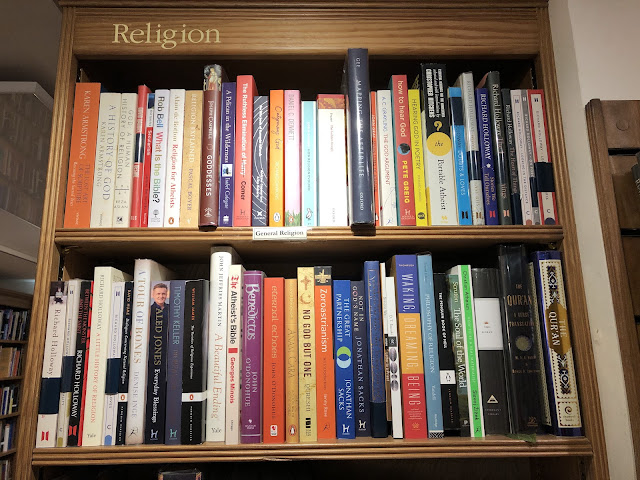I've spent the last two days in St. Andrews, another seaside town about an hour south of Stonehaven, on Scotland's east coast. St. Andrews is known in the United States as the home of golf. When I decided to bring my own golf clubs on sabbatical, I decided to re-route for a few days to St. Andrews to try my luck as a single golfer to play on the Old Course. Cut to the chase: no luck. I got as close as 8th in the line yesterday, but it was late in the day and I gave up to play one of the much-less-famous courses. I did play golf twice while I was here and both rounds were delightful and memorable, so I walk away from St. Andrews with no regrets about making this part of my trip.
St. Andrews is much more than a golf town, though. It's a modern university town, teeming with students. The university dates to the 1410s, but it's had a recent resurgence in popularity, due to several reasons, but probably most of all because it was the place where Prince William and Kate met as students. I know you're dying for some more about William and Kate so here's a picture of the unassuming building where they shared a flat when they were in school. That's all you're getting from me. Royalty is disgusting.
What's also interesting to me is how much St. Andrews feels like every university town everywhere I've ever been. There's a ton of cafes, bars, fast food, and clothing boutiques. As I sit here in the Student Union, they're playing Outkast on the sound system. The students are slouchy, geeky, depressed, or urbane, or all of the above. St. Andrews clearly draws bright kids from all over the world--I've seen every color of skin and heard many different languages. My suspicion about St. Andrews--which was true of my own college experience at Yale--is that the modern university is designed--consciously or unconsciouly--to prepare students to participate in the emerging class of global overlords.
There's a feeling that places like this insinuate: you are special, you are gifted, you deserve to have wealth and power. Elite universities churn out the global managerial class by the thousands every year--people who go into management consulting and finance--and become part of big multinational businesses, which are, by definition, trans-cultural. They live in elite neighborhoods, maintain elite tastes, travel to elite destinations. The university experience is the gateway--it takes you away from the place and people you came from, and it shapes you into someone who doesn't belong anywhere and who can only find solace among other elites whose similar master-of-the-universe jobs are circularly self-justifying.
St. Andrews reminds me visually of Yale--except its buildings are actually old (instead of Yale's, which are embarrassingly faux-old).
Like Yale, St. Andrews was formed to train students in religion. Today, we think of religion as a "niche" subject, but for centuries, religion wasn't a subject, but a worldview, encompassing and including all other disciplines like the sciences, philosophy, and literature. You can argue that it's better that religion doesn't have a dominant role in Western life anymore. But the advantage, I think, is that at least there was an effort to create a scientifically and morally coherent worldview--different disciplines were supposed to speak with one another, and ultimately, to cohere. Good luck getting a coherent worldview in any college curriculum today. Is an education that doesn't teach morality and seek a coherent worldview really a useful education? That's where we are. Religion is a niche. I visited a great local bookstore and the religion section is small and has about as many titled dedicated to atheism as it does religion.
St. Andrews used to be one of the most important religious cities in Scotland and it's got a fabulous religious history. The origin of this history is a (probably fictional) narrative that describes a Greek monk who had a vision to carry the bones of Jesus' disciple Andrew "to the northern edge of civilization." By legend, the edge turned out to be this seaside town in northern Britain. The bones (which were only three fingers, a kneecap, upper arm bone, and a tooth) generated a huge pilgrimage business--and St. Andrews boomed with tourists. As the money flowed in, church leaders built a massive cathedral--the largest in Scotland. Cha-ching.
Anytime the church gets wrapped up in big business, corruption infects the enterprise. The same was true here in St. Andrews, where church leaders were doing all kinds of crazy (think sex, killings, luxury goods) in the name of Jesus. The corruption drew predictable protests--St. Andrews became known for reformation and martyrdom. Two men--Patrick Hamilton, a St. Andrews professor and disciple of Luther, and George Wishart, an itinerant preacher and disciple of Calvin, who mentored John Knox--were both tried and martyred at St. Andrews in the early 1500s. The site of Hamilton's execution is marked by stones in the pavement and it is still seen as ominous luck to walk on them. Hillary Clinton reportedly walked on them during a visit prior to her presidential run. Dammit.
John Knox--likely a St. Andrews student--was imprisoned for his Calvinist beliefs, but he would later return to St. Andrews to preach and whip up the people into a anti-Catholic frenzy. I've always looked at the Protestant reforms as extremely courageous assholes. They did risk their lives, which is mostly admirable. But they also assumed incredibly stubborn and defiant postures over miniscule theological concepts, which, in the light of the passing centuries, looks foolish. But when you put yourself in their shoes and you look at how sinister and corrupt the church was in the time--and how the church held so much power and wealth and held it with absolute unaccountability and impunity--perhaps then, it becomes easier to understand why the reformers were willing to risk their lives and held such absolutist positions. They were fighting against the Empire--and nothing less than human freedom, they believed, was at stake.
The reformers carried the day--at least for a while--in Scotland. They burned the St. Andrews Cathedral in the 1560s and it was never rebuilt. It remains a shell today, a ghostly skeleton, a monument to religious corruption and power, exercised sinfully in the name of all that is good. I'm always glad for cultures that preserve monuments to human sin. Would America be different if we'd kept the lynching trees and the slave market platforms as a caution against our own self-righteousness?
St. Andrews is a great place to visit. You can wander for miles on the beach at West Sands, where they also filmed the iconic running scene from the movie Chariots of Fire. I was wearing boots and carrying a backpack, so I just strolled. But I did hum the tune.
My favorite part of my time here, hands down, was the Air BnB where I stayed--about a mile east of the center of town. Several times a day, I walked back and forth along the Kinness Burn, along Lade Braes Walk. It's a footpath that dates as early as the 12th century, but has recent updates to make it a fantastic walking area. The sounds of cooing doves and, yes, water falling over rocks, keep you company the whole way. Cottages along the burn like this one, with a capstone reading 1668, are still in working order. It's a pastoral fantasyland.
Finally, on a walk through town, I saw this car, which I think I recognize as a villain in one of the Cars movies.









No comments:
Post a Comment